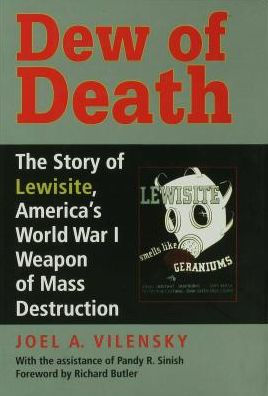"Dr. Vilensky raises important concerns regarding the threats posed
by lewisite and other weapons of mass destruction. As he describes,
non-proliferation programs are a vital component in the War on Terror." --
Richard G. Lugar, United States Senator
"Joel Vilensky's book
is a detailed and immensely useful account of the development and history of one of
the major chemical weapons.... We will always know how to make lewisite, the 'Dew of
Death,' but that does not mean that we should, or be compelled to accept such
weapons in our lives." -- from the Foreword by Richard Butler, former head of
UN Special Commission to Disarm Iraq
In 1919, when the Great War
was over, the New York Times reported on a new chemical weapon with "the
fragrance of geranium blossoms," a poison gas that was "the climax of this
country's achievements in the lethal arts." The name of this substance was
lewisite and this is its story -- the story of an American weapon of mass
destruction.
Discovered by accident by a graduate student and
priest in a chemistry laboratory at the Catholic University of America in
Washington, D.C., lewisite was developed into a weapon by Winford Lewis, who became
its namesake, working with a team led by James Conant, later president of Harvard
and head of government oversight for the U.S.'s atomic bomb program, the Manhattan
Project. After a powerful German counterattack in the spring of 1918, the government
began frantic production of lewisite in hopes of delivering 3,000 tons of the stuff
to be ready for use in Europe the following year. The end of war came just as the
first shipment was being prepared. It was dumped into the sea, but not forgotten.
Joel A. Vilensky tells the intriguing story of the discovery and
development of lewisite and its curious history. During World War II, the United
States produced more than 20,000 tons of lewisite, testing it on soldiers and
secretly dropping it from airplanes. In the end, the substance was abandoned as a
weapon because it was too unstable under most combat conditions. But a weapon once
discovered never disappears. It was used by Japan in Manchuria and by Iraq in its
war with Iran. The Soviet Union was once a major manufacturer. Strangely enough,
although it was developed for lethal purposes, lewisite led to an effective
treatment for a rare neurological disease.
"Dr. Vilensky raises important concerns regarding the threats posed
by lewisite and other weapons of mass destruction. As he describes,
non-proliferation programs are a vital component in the War on Terror." --
Richard G. Lugar, United States Senator
"Joel Vilensky's book
is a detailed and immensely useful account of the development and history of one of
the major chemical weapons.... We will always know how to make lewisite, the 'Dew of
Death,' but that does not mean that we should, or be compelled to accept such
weapons in our lives." -- from the Foreword by Richard Butler, former head of
UN Special Commission to Disarm Iraq
In 1919, when the Great War
was over, the New York Times reported on a new chemical weapon with "the
fragrance of geranium blossoms," a poison gas that was "the climax of this
country's achievements in the lethal arts." The name of this substance was
lewisite and this is its story -- the story of an American weapon of mass
destruction.
Discovered by accident by a graduate student and
priest in a chemistry laboratory at the Catholic University of America in
Washington, D.C., lewisite was developed into a weapon by Winford Lewis, who became
its namesake, working with a team led by James Conant, later president of Harvard
and head of government oversight for the U.S.'s atomic bomb program, the Manhattan
Project. After a powerful German counterattack in the spring of 1918, the government
began frantic production of lewisite in hopes of delivering 3,000 tons of the stuff
to be ready for use in Europe the following year. The end of war came just as the
first shipment was being prepared. It was dumped into the sea, but not forgotten.
Joel A. Vilensky tells the intriguing story of the discovery and
development of lewisite and its curious history. During World War II, the United
States produced more than 20,000 tons of lewisite, testing it on soldiers and
secretly dropping it from airplanes. In the end, the substance was abandoned as a
weapon because it was too unstable under most combat conditions. But a weapon once
discovered never disappears. It was used by Japan in Manchuria and by Iraq in its
war with Iran. The Soviet Union was once a major manufacturer. Strangely enough,
although it was developed for lethal purposes, lewisite led to an effective
treatment for a rare neurological disease.

Dew of Death: The Story of Lewisite, America's World War I Weapon of Mass Destruction
240
Dew of Death: The Story of Lewisite, America's World War I Weapon of Mass Destruction
240
Product Details
| ISBN-13: | 9780253111524 |
|---|---|
| Publisher: | Indiana University Press |
| Publication date: | 09/07/2005 |
| Sold by: | Barnes & Noble |
| Format: | eBook |
| Pages: | 240 |
| File size: | 2 MB |
